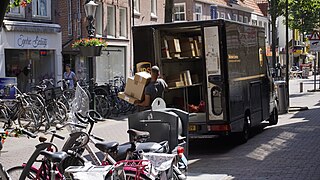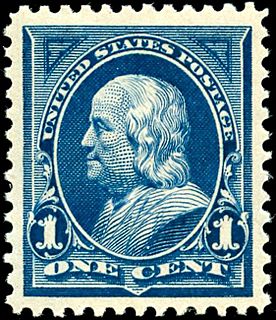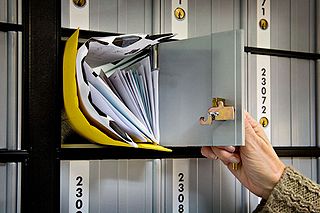Related Research Articles

A postmark is a postal marking made on an envelope, parcel, postcard or the like, indicating the place, date and time that the item was delivered into the care of a postal service, or sometimes indicating where and when received or in transit. Modern postmarks are often applied simultaneously with the cancellation or killer that marks postage stamps as having been used. Sometimes a postmark alone is used to cancel stamps, and the two terms are often used interchangeably. Postmarks may be applied by handstamp or machine, using methods such as rollers or inkjets, while digital postmarks are a recent innovation.

The United States Postal Service is an independent agency of the executive branch of the United States federal government responsible for providing postal service in the United States, including its insular areas and associated states. It is one of the few government agencies explicitly authorized by the United States Constitution.

The mail or post is a system for physically transporting postcards, letters, and parcels. A postal service can be private or public, though many governments place restrictions on private systems. Since the mid-19th century, national postal systems have generally been established as a government monopoly, with a fee on the article prepaid. Proof of payment is usually in the form of an adhesive postage stamp, but a postage meter is also used for bulk mailing. With the advent of email, the retronym "snail mail" was coined.

An envelope is a common packaging item, usually made of thin, flat material. It is designed to contain a flat object, such as a letter or card.
Canada Post Corporation, trading as Canada Post, is a Crown corporation which functions as the primary postal operator in Canada. Originally known as Royal Mail Canada, rebranding was done to the "Canada Post" name in the late 1960s, even though it had not yet been separated from the government. On October 16, 1981, the Canada Post Corporation Act came into effect. This abolished the Post Office Department and created the present day Crown corporation which provides postal service. The act aimed to set a new direction for the postal service by ensuring the postal service's financial security and independence.

Package delivery or parcel delivery is the delivery of shipping containers, parcels, or high value mail as single shipments. The service is provided by most postal systems, express mail, private courier companies, and less than truckload shipping carriers.
The Private Express Statutes (PES) are a group of United States federal civil and criminal laws placing various restrictions on the carriage and delivery of letters by all organizations other than the United States Postal Service.

The history of postal service of the United States began with the delivery of stampless letters, whose cost was borne by the receiving person, later also encompassed pre-paid letters carried by private mail carriers and provisional post offices, and culminated in a system of universal prepayment that required all letters to bear nationally issued adhesive postage stamps.

Postal history is the study of postal systems and how they operate and, or, the study of the use of postage stamps and covers and associated postal artifacts illustrating historical episodes in the development of postal systems. The term is attributed to Robson Lowe, a professional philatelist, stamp dealer and stamp auctioneer, who made the first organised study of the subject in the 1930s and described philatelists as "students of science", but postal historians as "students of humanity". More precisely, philatelists describe postal history as the study of rates, routes, markings, and means.
Stamps.com is an American company that provides Internet-based mailing and shipping services. Stamps.com is a public company and trades on the NASDAQ exchange under the symbol STMP. The company's main offices are located in El Segundo, California.

Registered mail is a mail service offered by postal services in many countries, which allows the sender proof of mailing via a mailing receipt and, upon request, electronic verification that an article was delivered or that a delivery attempt was made. Depending on the country, additional services may also be available, such as:

A post office box is a uniquely addressable lockable box located on the premises of a post office station.

The system for mail delivery in the United States has developed with the nation. Rates were based on the distance between sender and receiver in the early years of the nation. In the middle of the 19th century, rates stabilized to one price regardless of distance. Rates were relatively unchanged until 1968, when the price was increased every few years by a small amount. Comparing the increases with a price index, the price of a first class stamp has been steady. The logo for the Post Office showed a man on a running horse, even as the railroads and then motorized trucks moved mail. In 1970, the Post Office became the Postal Service, with rates set by the Postal Regulatory Commission, and some oversight by the Congress. Air mail became standard in 1975. In the 21st century, prices were segmented to match the sorting machinery in use; letters too large for the machines required slightly higher postage.

Freepost is a postal service provided by various postal administrations, whereby a person sends mail without affixing postage, and the recipient pays the postage when collecting the mail. Freepost differs from self-addressed stamped envelopes, courtesy reply mail, and metered reply mail in that the recipient of the freepost pays only for those items that are actually received, rather than for all that are distributed.
Post offices and other mail service providers typically offer a mail forwarding service, commonly known as hybrid mail or virtual post office box services, to redirect mail addressed to one location to another address – usually for a given period. In the case of the United States Postal Service's First Class Mail, it is generally for a period of one year. British Royal Mail provides a service called Mail Redirection, enabling redirection for up to two years. Customers of such a service usually, but not exclusively, use mail forwarding when they change an address.

Parcel post is a postal service for mail that is too heavy for normal letter post. It is usually slower than letter post. The development of the parcel post is closely connected with the development of the railway network which enabled parcels to be carried in bulk, to a regular schedule and at economic prices. Today many parcels also travel by road and international shipments may travel by sea or airmail.
Dimensional weight, also known as volumetric weight, is a pricing technique for commercial freight transport, which uses an estimated weight that is calculated from the length, width and height of a package.
A flat fee, also referred to as a flat rate or a linear rate refers to a pricing structure that charges a single fixed fee for a service, regardless of usage. Less commonly, the term may refer to a rate that does not vary with usage or time of use.

The Intelligent Mail Barcode is a 65-bar barcode for use on mail in the United States. The term "Intelligent Mail" refers to services offered by the United States Postal Service for domestic mail delivery. The IM barcode is intended to provide greater information and functionality than its predecessors POSTNET and PLANET. An Intelligent Mail barcode has also been referred to as a One Code Solution and a 4-State Customer Barcode, abbreviated 4CB, 4-CB or USPS4CB. The complete specification can be found in USPS Document USPS-B-3200. It effectively incorporates the routing ZIP code and tracking information included in previously used postal barcode standards.

The United States Postal Service (USPS) provides Priority Mail Express for domestic U.S. delivery, and offers two international Express Mail services, although only one of them is part of the EMS standard. One is called Priority Mail Express International and the other service is called Global Express Guaranteed (GXG). The latter having no relation whatsoever to "EMS" International service as provided by the EMS Cooperative.
References
- ↑ Trunkett, Oliver (28 January 2016). "The State of Click-N-Ship 2016, Changes and Rates". ShippingEasy.com. Retrieved 17 February 2017.
Click-N-Ship ... is a free and (not so) easy way to print shipping labels from home across a variety of USPS Shipping Services, and used to provide a discount over getting your labels made at the Post Office.
- ↑ Steiner, Ina (19 January 2016). "One Case Where It's Cheaper to Ship at the Post Office". eCommerce Bytes. Steiner Associates LLC. Retrieved 17 February 2017.
Click-N-Ship allows customers to print shipping labels with postage for Priority Mail, Priority Mail Express, Priority Mail International, Global Express Guaranteed and Priority Mail Express International.
- ↑ "Flat Rate". USPS.com. United States Postal Service. Retrieved 17 February 2017.
- ↑ "Online Shipping". USPS.com. United States Postal Service. Retrieved 17 February 2017.
To start Click & Ship, sign into or sign up for a free USPS.com account. Then you can enter your package details, pay for postage, print your shipping label, and schedule a free package pickup—and save a trip to our Post Offices.